Impact of Media Violence on Teenagers and Adolescents
VerifiedAdded on 2023/06/11
|8
|1677
|236
AI Summary
This paper evaluates the impact of media violence on teenagers and adolescents, especially boys, and the harmful effects it has on their mental health. It highlights the risks and threats associated with media violence and provides a plan to mitigate its harmful consequences.
Contribute Materials
Your contribution can guide someone’s learning journey. Share your
documents today.

Running head: PSYCHOLOGY
PSYCHOLOGY
Name of the Student:
Name of the University:
Author note:
PSYCHOLOGY
Name of the Student:
Name of the University:
Author note:
Secure Best Marks with AI Grader
Need help grading? Try our AI Grader for instant feedback on your assignments.
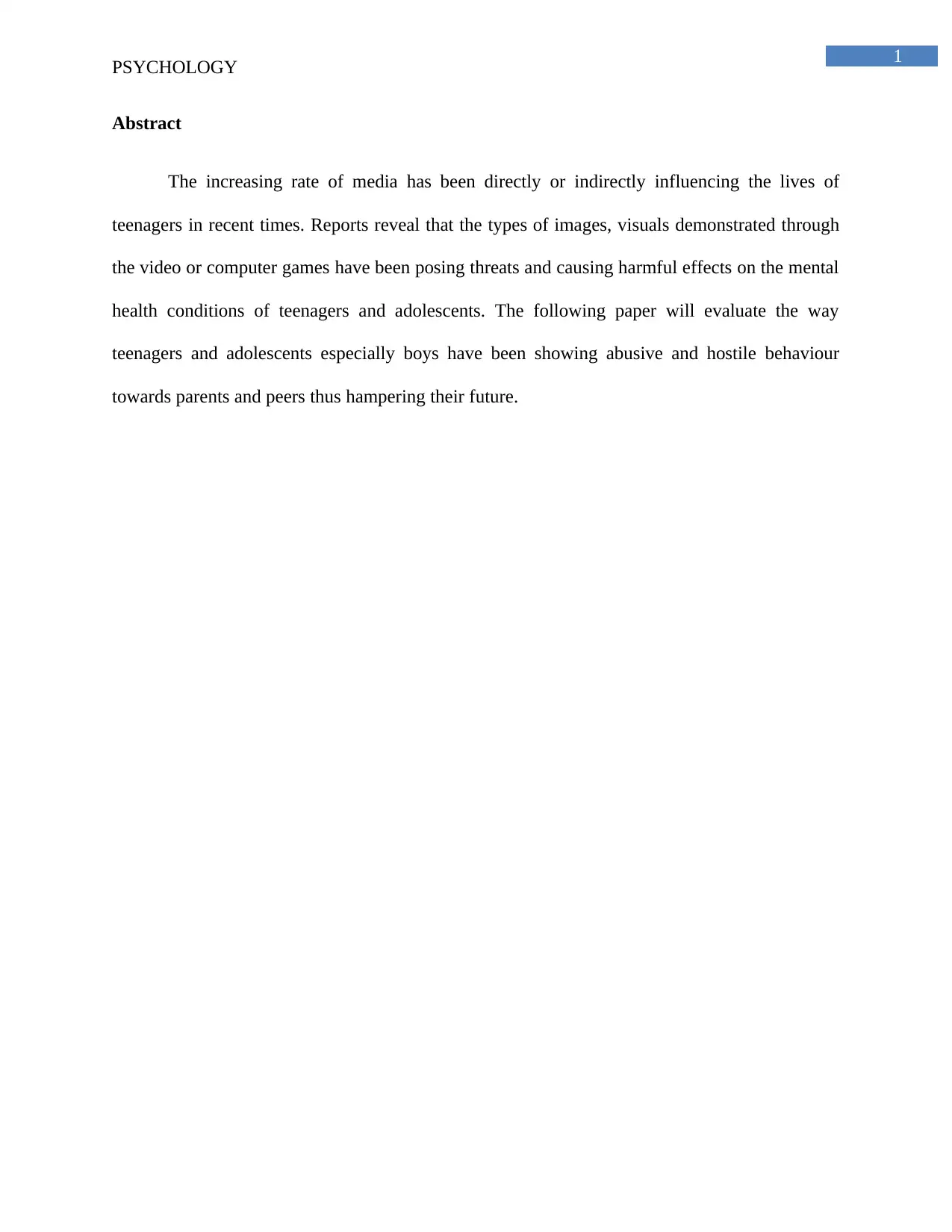
1
PSYCHOLOGY
Abstract
The increasing rate of media has been directly or indirectly influencing the lives of
teenagers in recent times. Reports reveal that the types of images, visuals demonstrated through
the video or computer games have been posing threats and causing harmful effects on the mental
health conditions of teenagers and adolescents. The following paper will evaluate the way
teenagers and adolescents especially boys have been showing abusive and hostile behaviour
towards parents and peers thus hampering their future.
PSYCHOLOGY
Abstract
The increasing rate of media has been directly or indirectly influencing the lives of
teenagers in recent times. Reports reveal that the types of images, visuals demonstrated through
the video or computer games have been posing threats and causing harmful effects on the mental
health conditions of teenagers and adolescents. The following paper will evaluate the way
teenagers and adolescents especially boys have been showing abusive and hostile behaviour
towards parents and peers thus hampering their future.
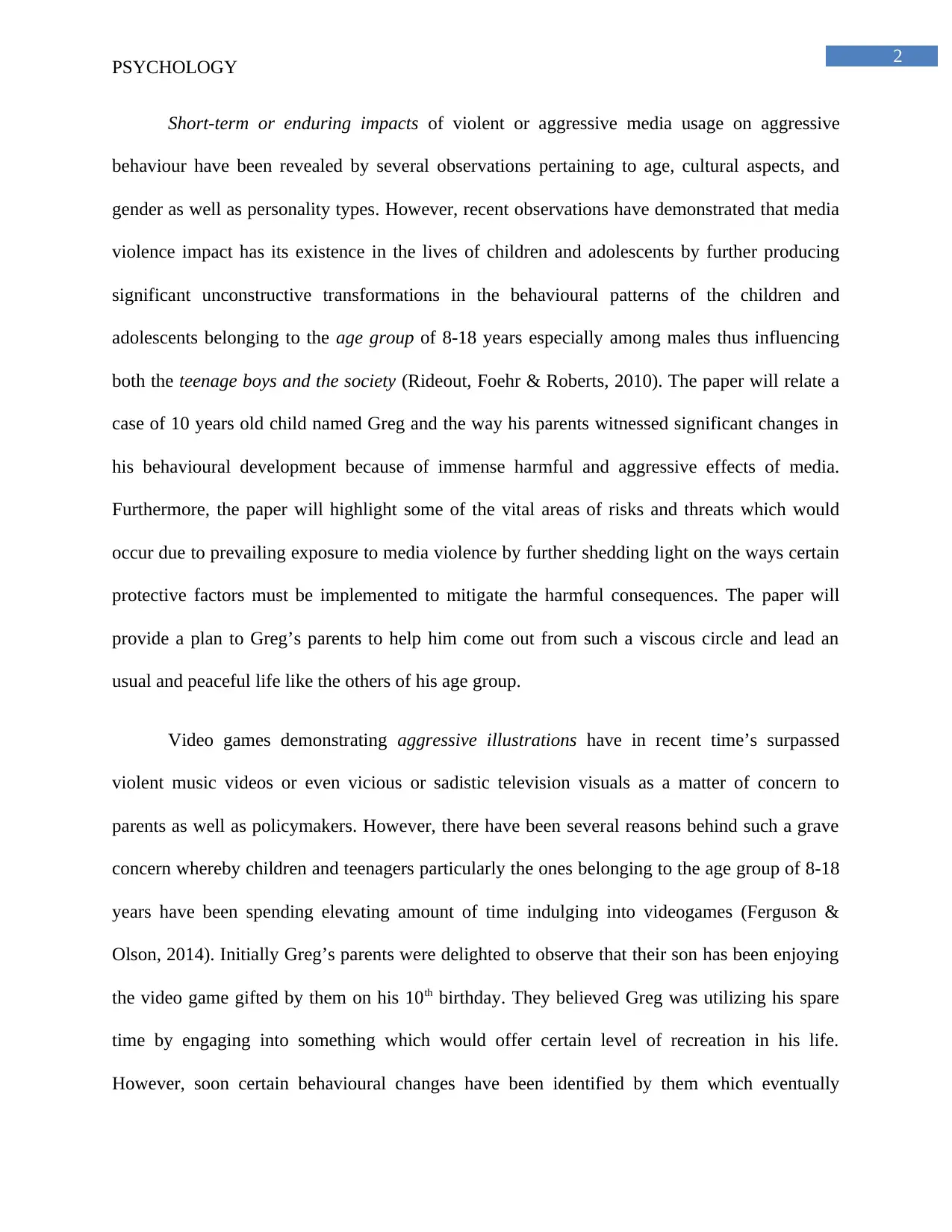
2
PSYCHOLOGY
Short-term or enduring impacts of violent or aggressive media usage on aggressive
behaviour have been revealed by several observations pertaining to age, cultural aspects, and
gender as well as personality types. However, recent observations have demonstrated that media
violence impact has its existence in the lives of children and adolescents by further producing
significant unconstructive transformations in the behavioural patterns of the children and
adolescents belonging to the age group of 8-18 years especially among males thus influencing
both the teenage boys and the society (Rideout, Foehr & Roberts, 2010). The paper will relate a
case of 10 years old child named Greg and the way his parents witnessed significant changes in
his behavioural development because of immense harmful and aggressive effects of media.
Furthermore, the paper will highlight some of the vital areas of risks and threats which would
occur due to prevailing exposure to media violence by further shedding light on the ways certain
protective factors must be implemented to mitigate the harmful consequences. The paper will
provide a plan to Greg’s parents to help him come out from such a viscous circle and lead an
usual and peaceful life like the others of his age group.
Video games demonstrating aggressive illustrations have in recent time’s surpassed
violent music videos or even vicious or sadistic television visuals as a matter of concern to
parents as well as policymakers. However, there have been several reasons behind such a grave
concern whereby children and teenagers particularly the ones belonging to the age group of 8-18
years have been spending elevating amount of time indulging into videogames (Ferguson &
Olson, 2014). Initially Greg’s parents were delighted to observe that their son has been enjoying
the video game gifted by them on his 10th birthday. They believed Greg was utilizing his spare
time by engaging into something which would offer certain level of recreation in his life.
However, soon certain behavioural changes have been identified by them which eventually
PSYCHOLOGY
Short-term or enduring impacts of violent or aggressive media usage on aggressive
behaviour have been revealed by several observations pertaining to age, cultural aspects, and
gender as well as personality types. However, recent observations have demonstrated that media
violence impact has its existence in the lives of children and adolescents by further producing
significant unconstructive transformations in the behavioural patterns of the children and
adolescents belonging to the age group of 8-18 years especially among males thus influencing
both the teenage boys and the society (Rideout, Foehr & Roberts, 2010). The paper will relate a
case of 10 years old child named Greg and the way his parents witnessed significant changes in
his behavioural development because of immense harmful and aggressive effects of media.
Furthermore, the paper will highlight some of the vital areas of risks and threats which would
occur due to prevailing exposure to media violence by further shedding light on the ways certain
protective factors must be implemented to mitigate the harmful consequences. The paper will
provide a plan to Greg’s parents to help him come out from such a viscous circle and lead an
usual and peaceful life like the others of his age group.
Video games demonstrating aggressive illustrations have in recent time’s surpassed
violent music videos or even vicious or sadistic television visuals as a matter of concern to
parents as well as policymakers. However, there have been several reasons behind such a grave
concern whereby children and teenagers particularly the ones belonging to the age group of 8-18
years have been spending elevating amount of time indulging into videogames (Ferguson &
Olson, 2014). Initially Greg’s parents were delighted to observe that their son has been enjoying
the video game gifted by them on his 10th birthday. They believed Greg was utilizing his spare
time by engaging into something which would offer certain level of recreation in his life.
However, soon certain behavioural changes have been identified by them which eventually
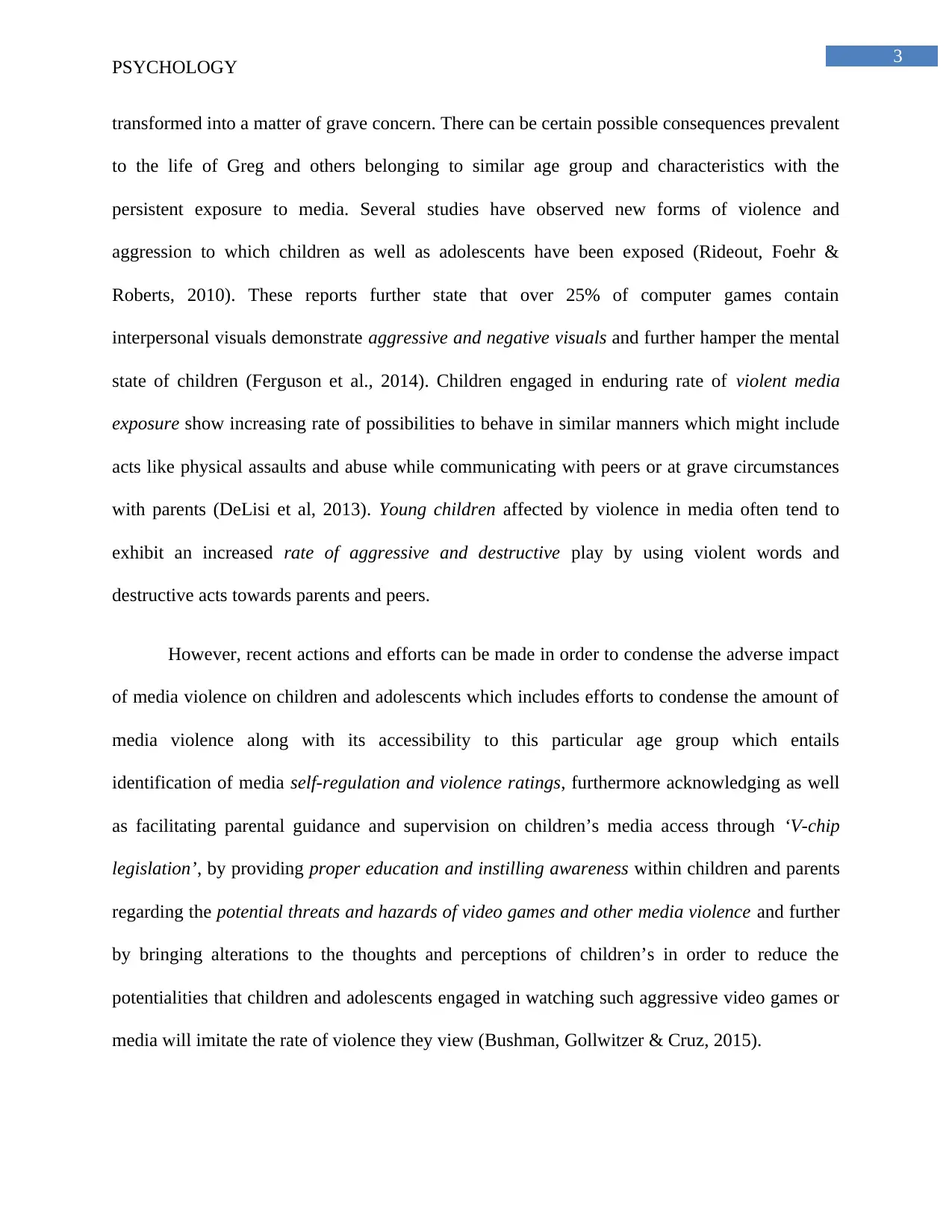
3
PSYCHOLOGY
transformed into a matter of grave concern. There can be certain possible consequences prevalent
to the life of Greg and others belonging to similar age group and characteristics with the
persistent exposure to media. Several studies have observed new forms of violence and
aggression to which children as well as adolescents have been exposed (Rideout, Foehr &
Roberts, 2010). These reports further state that over 25% of computer games contain
interpersonal visuals demonstrate aggressive and negative visuals and further hamper the mental
state of children (Ferguson et al., 2014). Children engaged in enduring rate of violent media
exposure show increasing rate of possibilities to behave in similar manners which might include
acts like physical assaults and abuse while communicating with peers or at grave circumstances
with parents (DeLisi et al, 2013). Young children affected by violence in media often tend to
exhibit an increased rate of aggressive and destructive play by using violent words and
destructive acts towards parents and peers.
However, recent actions and efforts can be made in order to condense the adverse impact
of media violence on children and adolescents which includes efforts to condense the amount of
media violence along with its accessibility to this particular age group which entails
identification of media self-regulation and violence ratings, furthermore acknowledging as well
as facilitating parental guidance and supervision on children’s media access through ‘V-chip
legislation’, by providing proper education and instilling awareness within children and parents
regarding the potential threats and hazards of video games and other media violence and further
by bringing alterations to the thoughts and perceptions of children’s in order to reduce the
potentialities that children and adolescents engaged in watching such aggressive video games or
media will imitate the rate of violence they view (Bushman, Gollwitzer & Cruz, 2015).
PSYCHOLOGY
transformed into a matter of grave concern. There can be certain possible consequences prevalent
to the life of Greg and others belonging to similar age group and characteristics with the
persistent exposure to media. Several studies have observed new forms of violence and
aggression to which children as well as adolescents have been exposed (Rideout, Foehr &
Roberts, 2010). These reports further state that over 25% of computer games contain
interpersonal visuals demonstrate aggressive and negative visuals and further hamper the mental
state of children (Ferguson et al., 2014). Children engaged in enduring rate of violent media
exposure show increasing rate of possibilities to behave in similar manners which might include
acts like physical assaults and abuse while communicating with peers or at grave circumstances
with parents (DeLisi et al, 2013). Young children affected by violence in media often tend to
exhibit an increased rate of aggressive and destructive play by using violent words and
destructive acts towards parents and peers.
However, recent actions and efforts can be made in order to condense the adverse impact
of media violence on children and adolescents which includes efforts to condense the amount of
media violence along with its accessibility to this particular age group which entails
identification of media self-regulation and violence ratings, furthermore acknowledging as well
as facilitating parental guidance and supervision on children’s media access through ‘V-chip
legislation’, by providing proper education and instilling awareness within children and parents
regarding the potential threats and hazards of video games and other media violence and further
by bringing alterations to the thoughts and perceptions of children’s in order to reduce the
potentialities that children and adolescents engaged in watching such aggressive video games or
media will imitate the rate of violence they view (Bushman, Gollwitzer & Cruz, 2015).
Secure Best Marks with AI Grader
Need help grading? Try our AI Grader for instant feedback on your assignments.
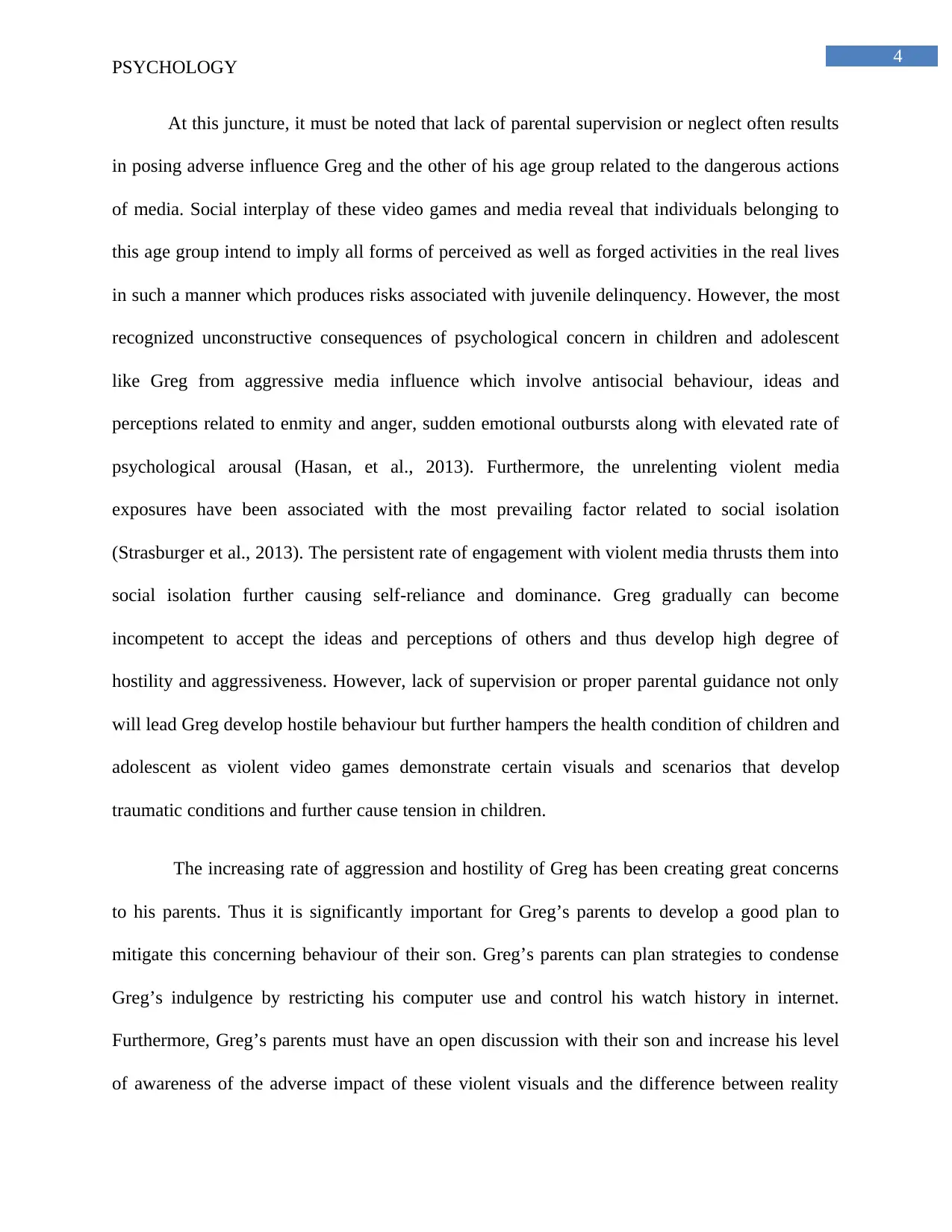
4
PSYCHOLOGY
At this juncture, it must be noted that lack of parental supervision or neglect often results
in posing adverse influence Greg and the other of his age group related to the dangerous actions
of media. Social interplay of these video games and media reveal that individuals belonging to
this age group intend to imply all forms of perceived as well as forged activities in the real lives
in such a manner which produces risks associated with juvenile delinquency. However, the most
recognized unconstructive consequences of psychological concern in children and adolescent
like Greg from aggressive media influence which involve antisocial behaviour, ideas and
perceptions related to enmity and anger, sudden emotional outbursts along with elevated rate of
psychological arousal (Hasan, et al., 2013). Furthermore, the unrelenting violent media
exposures have been associated with the most prevailing factor related to social isolation
(Strasburger et al., 2013). The persistent rate of engagement with violent media thrusts them into
social isolation further causing self-reliance and dominance. Greg gradually can become
incompetent to accept the ideas and perceptions of others and thus develop high degree of
hostility and aggressiveness. However, lack of supervision or proper parental guidance not only
will lead Greg develop hostile behaviour but further hampers the health condition of children and
adolescent as violent video games demonstrate certain visuals and scenarios that develop
traumatic conditions and further cause tension in children.
The increasing rate of aggression and hostility of Greg has been creating great concerns
to his parents. Thus it is significantly important for Greg’s parents to develop a good plan to
mitigate this concerning behaviour of their son. Greg’s parents can plan strategies to condense
Greg’s indulgence by restricting his computer use and control his watch history in internet.
Furthermore, Greg’s parents must have an open discussion with their son and increase his level
of awareness of the adverse impact of these violent visuals and the difference between reality
PSYCHOLOGY
At this juncture, it must be noted that lack of parental supervision or neglect often results
in posing adverse influence Greg and the other of his age group related to the dangerous actions
of media. Social interplay of these video games and media reveal that individuals belonging to
this age group intend to imply all forms of perceived as well as forged activities in the real lives
in such a manner which produces risks associated with juvenile delinquency. However, the most
recognized unconstructive consequences of psychological concern in children and adolescent
like Greg from aggressive media influence which involve antisocial behaviour, ideas and
perceptions related to enmity and anger, sudden emotional outbursts along with elevated rate of
psychological arousal (Hasan, et al., 2013). Furthermore, the unrelenting violent media
exposures have been associated with the most prevailing factor related to social isolation
(Strasburger et al., 2013). The persistent rate of engagement with violent media thrusts them into
social isolation further causing self-reliance and dominance. Greg gradually can become
incompetent to accept the ideas and perceptions of others and thus develop high degree of
hostility and aggressiveness. However, lack of supervision or proper parental guidance not only
will lead Greg develop hostile behaviour but further hampers the health condition of children and
adolescent as violent video games demonstrate certain visuals and scenarios that develop
traumatic conditions and further cause tension in children.
The increasing rate of aggression and hostility of Greg has been creating great concerns
to his parents. Thus it is significantly important for Greg’s parents to develop a good plan to
mitigate this concerning behaviour of their son. Greg’s parents can plan strategies to condense
Greg’s indulgence by restricting his computer use and control his watch history in internet.
Furthermore, Greg’s parents must have an open discussion with their son and increase his level
of awareness of the adverse impact of these violent visuals and the difference between reality

5
PSYCHOLOGY
and fantasy (Center for Media Literacy, 2018). Greg’s parents can also educate themselves by
adapting media literacy curricula which provides a range of tools to aid parents as well as
children analyse the styles implemented to stage aggressive visuals. Lastly, Greg’s parents can
implement strategies to engage him in national debates and discussions over media violence
whereby he will be able to listen to the opinions and perceptions of children of his age. This
would help him to obtain adequate knowledge and awareness of these acts and further encourage
him to take active participation in these debates.
PSYCHOLOGY
and fantasy (Center for Media Literacy, 2018). Greg’s parents can also educate themselves by
adapting media literacy curricula which provides a range of tools to aid parents as well as
children analyse the styles implemented to stage aggressive visuals. Lastly, Greg’s parents can
implement strategies to engage him in national debates and discussions over media violence
whereby he will be able to listen to the opinions and perceptions of children of his age. This
would help him to obtain adequate knowledge and awareness of these acts and further encourage
him to take active participation in these debates.
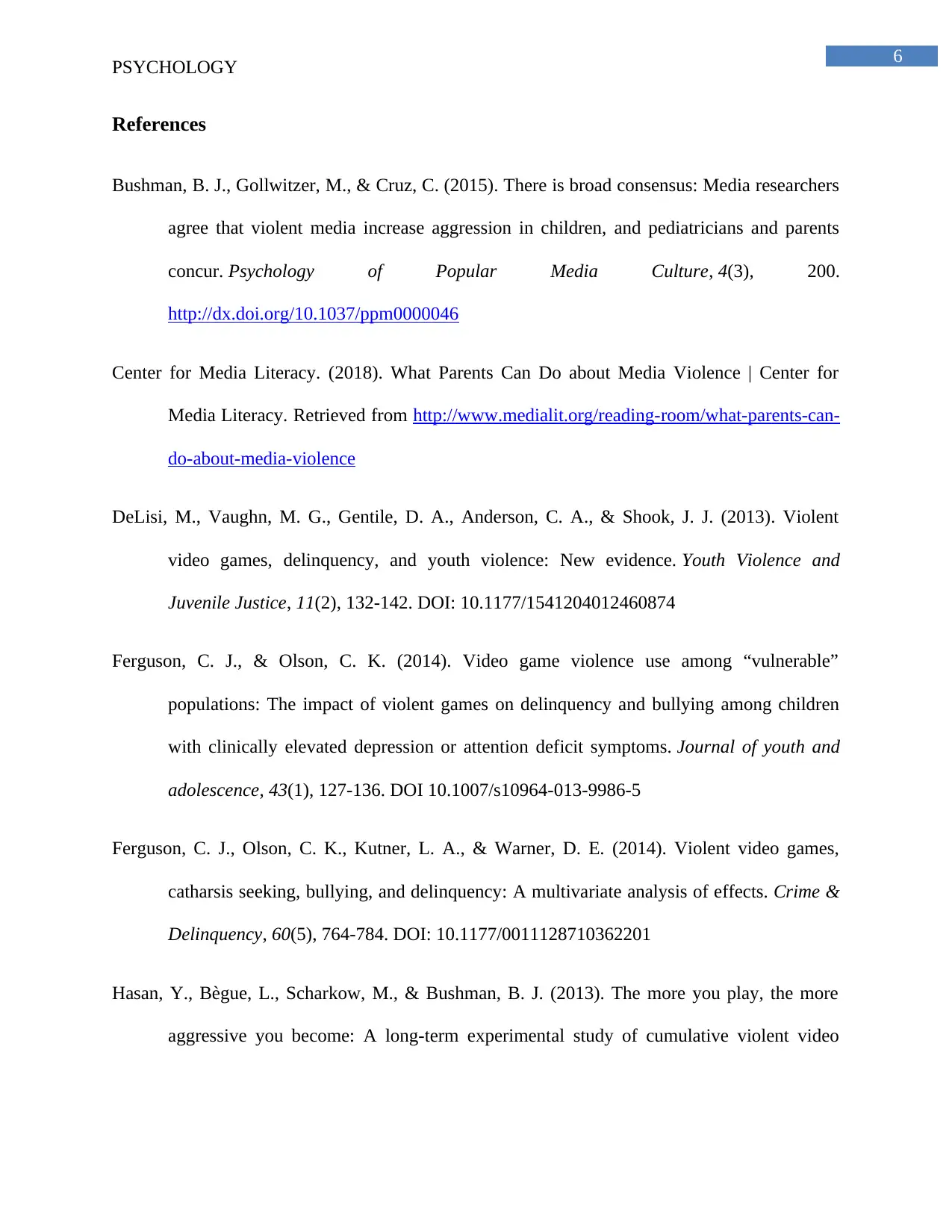
6
PSYCHOLOGY
References
Bushman, B. J., Gollwitzer, M., & Cruz, C. (2015). There is broad consensus: Media researchers
agree that violent media increase aggression in children, and pediatricians and parents
concur. Psychology of Popular Media Culture, 4(3), 200.
http://dx.doi.org/10.1037/ppm0000046
Center for Media Literacy. (2018). What Parents Can Do about Media Violence | Center for
Media Literacy. Retrieved from http://www.medialit.org/reading-room/what-parents-can-
do-about-media-violence
DeLisi, M., Vaughn, M. G., Gentile, D. A., Anderson, C. A., & Shook, J. J. (2013). Violent
video games, delinquency, and youth violence: New evidence. Youth Violence and
Juvenile Justice, 11(2), 132-142. DOI: 10.1177/1541204012460874
Ferguson, C. J., & Olson, C. K. (2014). Video game violence use among “vulnerable”
populations: The impact of violent games on delinquency and bullying among children
with clinically elevated depression or attention deficit symptoms. Journal of youth and
adolescence, 43(1), 127-136. DOI 10.1007/s10964-013-9986-5
Ferguson, C. J., Olson, C. K., Kutner, L. A., & Warner, D. E. (2014). Violent video games,
catharsis seeking, bullying, and delinquency: A multivariate analysis of effects. Crime &
Delinquency, 60(5), 764-784. DOI: 10.1177/0011128710362201
Hasan, Y., Bègue, L., Scharkow, M., & Bushman, B. J. (2013). The more you play, the more
aggressive you become: A long-term experimental study of cumulative violent video
PSYCHOLOGY
References
Bushman, B. J., Gollwitzer, M., & Cruz, C. (2015). There is broad consensus: Media researchers
agree that violent media increase aggression in children, and pediatricians and parents
concur. Psychology of Popular Media Culture, 4(3), 200.
http://dx.doi.org/10.1037/ppm0000046
Center for Media Literacy. (2018). What Parents Can Do about Media Violence | Center for
Media Literacy. Retrieved from http://www.medialit.org/reading-room/what-parents-can-
do-about-media-violence
DeLisi, M., Vaughn, M. G., Gentile, D. A., Anderson, C. A., & Shook, J. J. (2013). Violent
video games, delinquency, and youth violence: New evidence. Youth Violence and
Juvenile Justice, 11(2), 132-142. DOI: 10.1177/1541204012460874
Ferguson, C. J., & Olson, C. K. (2014). Video game violence use among “vulnerable”
populations: The impact of violent games on delinquency and bullying among children
with clinically elevated depression or attention deficit symptoms. Journal of youth and
adolescence, 43(1), 127-136. DOI 10.1007/s10964-013-9986-5
Ferguson, C. J., Olson, C. K., Kutner, L. A., & Warner, D. E. (2014). Violent video games,
catharsis seeking, bullying, and delinquency: A multivariate analysis of effects. Crime &
Delinquency, 60(5), 764-784. DOI: 10.1177/0011128710362201
Hasan, Y., Bègue, L., Scharkow, M., & Bushman, B. J. (2013). The more you play, the more
aggressive you become: A long-term experimental study of cumulative violent video
Paraphrase This Document
Need a fresh take? Get an instant paraphrase of this document with our AI Paraphraser
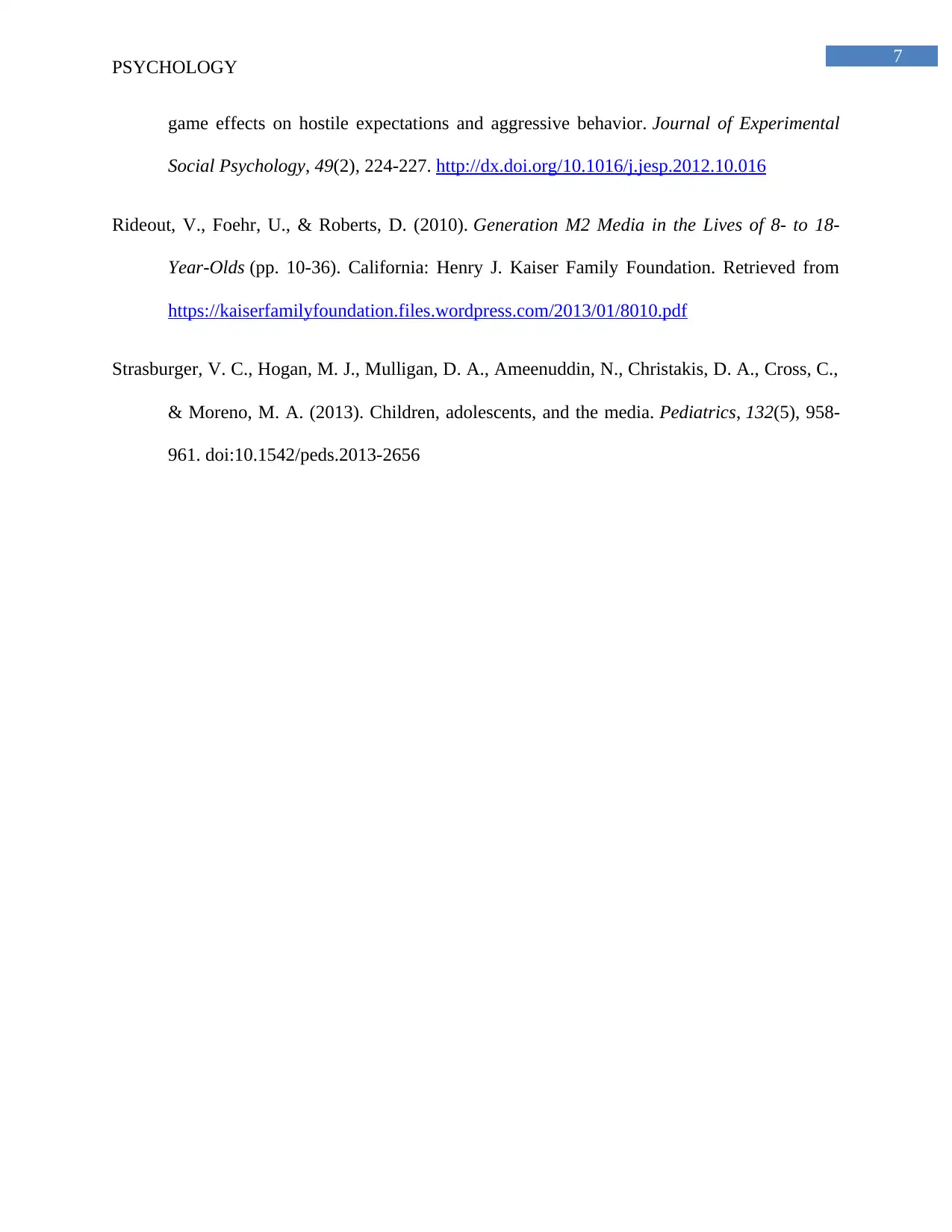
7
PSYCHOLOGY
game effects on hostile expectations and aggressive behavior. Journal of Experimental
Social Psychology, 49(2), 224-227. http://dx.doi.org/10.1016/j.jesp.2012.10.016
Rideout, V., Foehr, U., & Roberts, D. (2010). Generation M2 Media in the Lives of 8- to 18-
Year-Olds (pp. 10-36). California: Henry J. Kaiser Family Foundation. Retrieved from
https://kaiserfamilyfoundation.files.wordpress.com/2013/01/8010.pdf
Strasburger, V. C., Hogan, M. J., Mulligan, D. A., Ameenuddin, N., Christakis, D. A., Cross, C.,
& Moreno, M. A. (2013). Children, adolescents, and the media. Pediatrics, 132(5), 958-
961. doi:10.1542/peds.2013-2656
PSYCHOLOGY
game effects on hostile expectations and aggressive behavior. Journal of Experimental
Social Psychology, 49(2), 224-227. http://dx.doi.org/10.1016/j.jesp.2012.10.016
Rideout, V., Foehr, U., & Roberts, D. (2010). Generation M2 Media in the Lives of 8- to 18-
Year-Olds (pp. 10-36). California: Henry J. Kaiser Family Foundation. Retrieved from
https://kaiserfamilyfoundation.files.wordpress.com/2013/01/8010.pdf
Strasburger, V. C., Hogan, M. J., Mulligan, D. A., Ameenuddin, N., Christakis, D. A., Cross, C.,
& Moreno, M. A. (2013). Children, adolescents, and the media. Pediatrics, 132(5), 958-
961. doi:10.1542/peds.2013-2656
1 out of 8
Related Documents
Your All-in-One AI-Powered Toolkit for Academic Success.
+13062052269
info@desklib.com
Available 24*7 on WhatsApp / Email
![[object Object]](/_next/static/media/star-bottom.7253800d.svg)
Unlock your academic potential
© 2024 | Zucol Services PVT LTD | All rights reserved.





